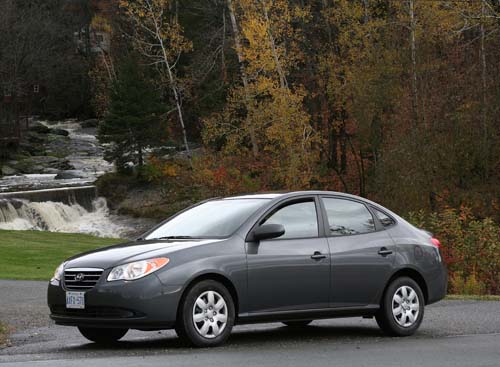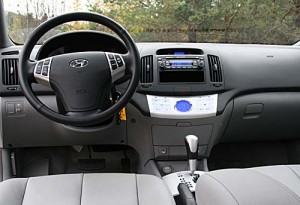2007 Hyundai Elantra
At the launch of the all-new 2007 Elantra, Hyundai made no bones about the fact that this is the most competitive segment in the Canadian marketplace. This, the fourth generation Elantra, was designed to build on the company’s market share.
The new Elantra styling marks a significant departure from the outgoing model, which keeps it in step with the sleek, mainstream look of the other models Hyundai has launched (seven new models in 24-months). The director of styling for Hyundai and Kia in Korea, Young-Il Kim, spoke about the need for both companies to develop separate identities that are uniquely Korean. Under his direction, styling of both brands will pick up on Korean themes – both its landscape and cultural icons. The flowing curved lines that highlight the side profile of the Elantra are a reflection of the flowing lines found in Korean architecture. It is a softer approach to the harder lines favoured by other Asian manufacturers.
The new Elantra comes in 5 trim levels: The base GL includes dual front airbags, power front windows and intermittent wipers but needs an $800 option package to add air conditioning, power rear windows, an AM/FM/CD/MP3 stereo and power door locks (these automatically unlock in the event of a crash, which eases access to the occupants). The GL Comfort adds power mirrors, manual drivers’ seat height adjustment, heated cloth seats, cruise control, front and rear centre armrests and keyless remote entry with alarm. The GL Comfort Plus features a total of 6 airbags, 4-channel anti-lock brakes, active headrests and steering mounted audio controls. The GL Sport includes a leather-wrapped steering wheel and shifter, power sunroof, trip computer, 16-inch alloy wheels and a rear deck spoiler. The GLS is loaded and counts automatic climate control system, leather seating a 4 speed automatic transmission as standard equipment.
While the overall length of the new Elantra has actually decreased by 20-mm, the wheelbase grown by 40-mm, the roofline has been raised 65-mm and the width increased by 50-mm. The net effect means the Elantra is now classified as a mid-sized car – the interior room exceeds that found in other compact models and the likes of the Acura TL. In real world terms, the driver’s cockpit is spacious with an impressive amount of headroom, even in the sunroof-equipped models. Rear seat room is just as generous, which gives three adults room enough for shorter trips without too much griping.
Functional utility adds value to the package with 60/40 split folding rear seats and plenty of storage compartments scattered throughout the cabin – the ones that fall within reach of the driver are particularly welcome.
The interior fit and finish is also well above average, which is something we’ve come to expect from Hyundai. The company’s build quality is such it has earned them a top three ranking in the J.D. Power Initial Build Quality survey. On the test drive, the lack of road and wind noise (in spite of the pretty nasty weather) suggests the Elantra will continue this level of satisfaction.
The interior is also well laid out and ergonomically sound. The large heating and ventilation controls found on the mid and lower trim level Elantras are a paragon of simplicity and a pleasure to use. The digital climate control system found in the up-market GLS works just as well while adding a sense of refinement to the cabin.
Hyundai has fitted all North American Elantras with its 2.0L four-cylinder Beta II engine. This power plant spools out 138 horsepower and 136 pound-feet of torque, which is pretty much standard for vehicles in the class. This engine comes with the full gamut of modern technology including double overhead cams, four valves per cylinder, continuously variable valve timing and a lightweight aluminum cylinder head. The engine revs freely and only when pushed to the limit does it begin to protest loudly.
Elantra comes with two transmission choices – a five-speed manual and a four-speed automatic (the GLS in automatic only). In real world driving, the auto does a decent job of keeping the engine in its power band and never seemed to stumble or hunt for gears. As one would expect the manual gearbox delivers a livelier driving experience. On the highway, the Elantra reverses conventional wisdom as the five-speed manual forces the engine to turn at higher rpm than the automatic. This will have an adverse effect on highway fuel economy.
Pushing the wheels out to the corners impacts both visual elements and the ride quality. The longer wheelbase combined with McPherson struts up front and a multi link set up at the rear helps to deliver a smoother ride. Simply, the suspension feels more capable, as it absorbs potholes without the kick back into the cabin the previous model displayed. It is also dishes out an equal measure of handling, making the twisty sections of the test drive a blast. The 16-inch tires on the GL Sport and top-of-the-line GLS provide a quieter and more nimble feel than the standard 14-inchers found on other models, and so the upgrade is worth considering at purchase time.
The Elantra is a peppy package. Informal testing put the 0-100 Km/h run with the manual transmission at about nine seconds and the automatic a tad over 10 seconds. Both times are in line with what’s expected of an entry-level car. It also means the Elantra will not be marketed as a pocket-rocket.
The new 2007 Elantras are in showrooms now and Hyundai Auto Canada expects the GL Comfort to be the volume model claiming up to 40% of sales. The GL Comfort Plus comes next followed by the GL with Air and the GL Sport. The upscale GLS will likely be the slow seller – it begins to encroach on sales of the Sonata.
Hyundai has established itself as a contemporary brand with products that stand on their reputation for quality and reliability. No longer content to be the cheaper alternative, Hyundai wants to be known for delivering the best value on the market. The latest Elantra brings that goal ever closer.
Specifications
Base Price: $15,595 (GL)
Body Type: 4-door sedan
Layout: front-engine, FWD
Engine: 2.0L, 16-valve, DOHC I-4
Horsepower: 138 @ 6,500 rpm
Torque: 136 lb-ft @ 5,200 rpm
Transmission: 5-spd manual/ 4 spd automatic
Length: 4,505 mm
Width: 1,775 mm
Height: 1,480 mm
Wheelbase: 2,635 mm
Brakes (front/rear): disc/drum or disc/disc
Weight: 1,235 kg (2,717 lbs)
Fuel Economy: (city/hwy, estimated) 8.4 / 6.0 L/100 km
Copyright © Auto Reviews Online 2016 | Privacy & Terms of Use | info@autoreviewsonline.com | Website by Brolly Media


